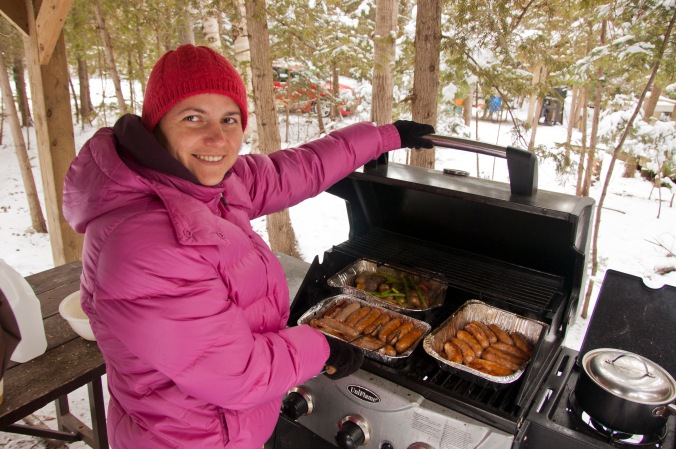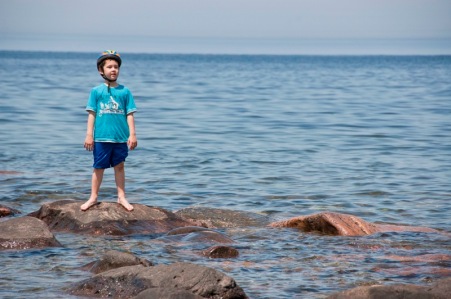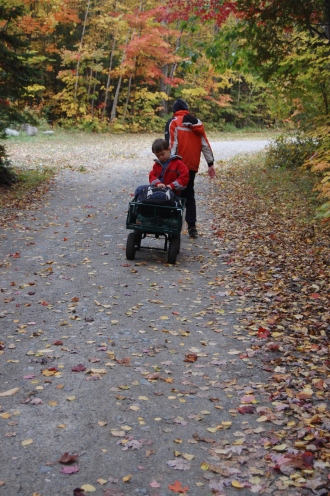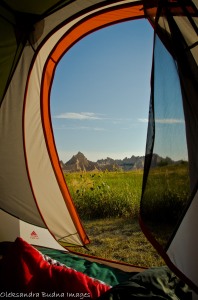If you read my previous post, you know how much I love winter camping. Now I have a confession to make: I haven’t always been a fan of winter. It is definitely an acquired taste. The secret is wearing proper clothes and getting involved in winter activities. Here are some tips to help plan a winter camping trip.


Warm clothes
Proper clothing is key to enjoying winter. Invest in a good winter coat, snowpants, hat, scarf, waterproof gloves or mittens, warm socks, waterproof boots. It is also important to dress not only according to the weather but consider what you are planning to do outside. Some activities, like hiking, cross-country skiing or skating, are more physically demanding and may cause overheating. Sweat is definitely not your friend when the temperature is below freezing. So layers that can be taken off and put back on are always a good idea.
Start with a base layer, which is usually long underwear or any other tight-fitting clothes. Base layers should be made of fabrics like polyester, merino wool, silk or blends that wick moisture and dry quickly. Cotton would be the worst choice for a base layer. Follow with a mid-layer, which can be a long-sleeved shirt, sweater or fleece vest. Finally, add the insulating layer, such as a fleece jacket or a down vest, followed by a waterproof and windproof shell. Some winter jackets already come with a built-in, removable fleece jacket or insulated liner.
Don’t forget to bring lots of extra socks, hats and gloves, especially for kids, as those tend to get wet during snow play and may not dry fast enough.

Roofed accommodations
As I mentioned before, we usually stay in a yurt or cabin in the winter although winter tenting is definitely on our bucket list. Quite a few Ontario Parks offer roofed accommodations, mostly yurts, which come with two sets of futon bunk beds, a table and chairs, electrical or gas heat, fluorescent lighting, and one electrical outlet. Outside, yurt sites have a picnic table, BBQ and fire pit. Some parks have camping cabins and cottages. Learn more about Ontario Parks roofed accommodations here.
Keep in mind that yurts and cabins for long weekends get booked fast, usually five months in advance so non-long weekends or middle of the week may be a better bet. We have been known to miss the reservation dates a few times but were able to book a last minute cabin in the Allegany State Park south of the border.

Yurt at Killarney Provincial Park

Cabin at Allegany State Park
Winter activities
You will never run out of things to do. Lots of Ontario Parks have snowshoeing and cross-country trails, skating rinks and toboggan hills. Not all of them offer equipment rentals, though, so check before you go. Find an outfitter somewhere close to the park or rent equipment from your local Mountain Equipment Co-op store. Plus, there are a lot of activities that don’t require any equipment at all.


Important thing to remember is that it gets dark early in the winter. So plan to come back from the trail at least an hour before sunset. Also remember to plan activities for long winter nights. Reading, playing charades, telling stories, talking around the fire, singing, and making rainbow loom bracelets are all fantastic ways to spend time. If you don’t play board games, this would be a good time to start. It’s a great bonding experience and way more fun that electronics. In addition, parks offer fun things to do after dark, like skating around the lit loops at Arrowhead and MacGregor Point.

Snacks and drinks
Our bodies need more calories in the winter so we always bring lots of snacks and drinks with us on a trail. Good snacks have low water content and high fat content to prevent them from freezing so think nuts, dried fruit, granola bars, trail mixes, crackers, cheese, cookies and chocolate. Hot chocolate or tea on the trail taste divine so we do bring a thermos with us even though it is heavy. The parks also have warming huts along the trails, a great place to rest and fuel up.
In terms of regular meals, yurts in Ontario Parks have BBQs with a side burner. It’s important to remember, though, that you’ll be cooking outside. So think foods that don’t need a lot of time to prepare.

Back in our meat-eating days


Play safe
Make sure the whole family is wearing proper safety gear, for instance helmets when skating, and whatever equipment you are using (skates, skis, snowshoes, etc.) fit everyone perfectly. Be careful around frozen bodies of water and ensure a tobogganing hill doesn’t end up on a road. Limit exposure on particularly cold days and know how to recognize and treat, but most importantly prevent, hypothermia and frostbite.

Winter in Canada is way too long to spend it cooped up inside. Embracing and enjoying it sounds like a much better plan!






























































